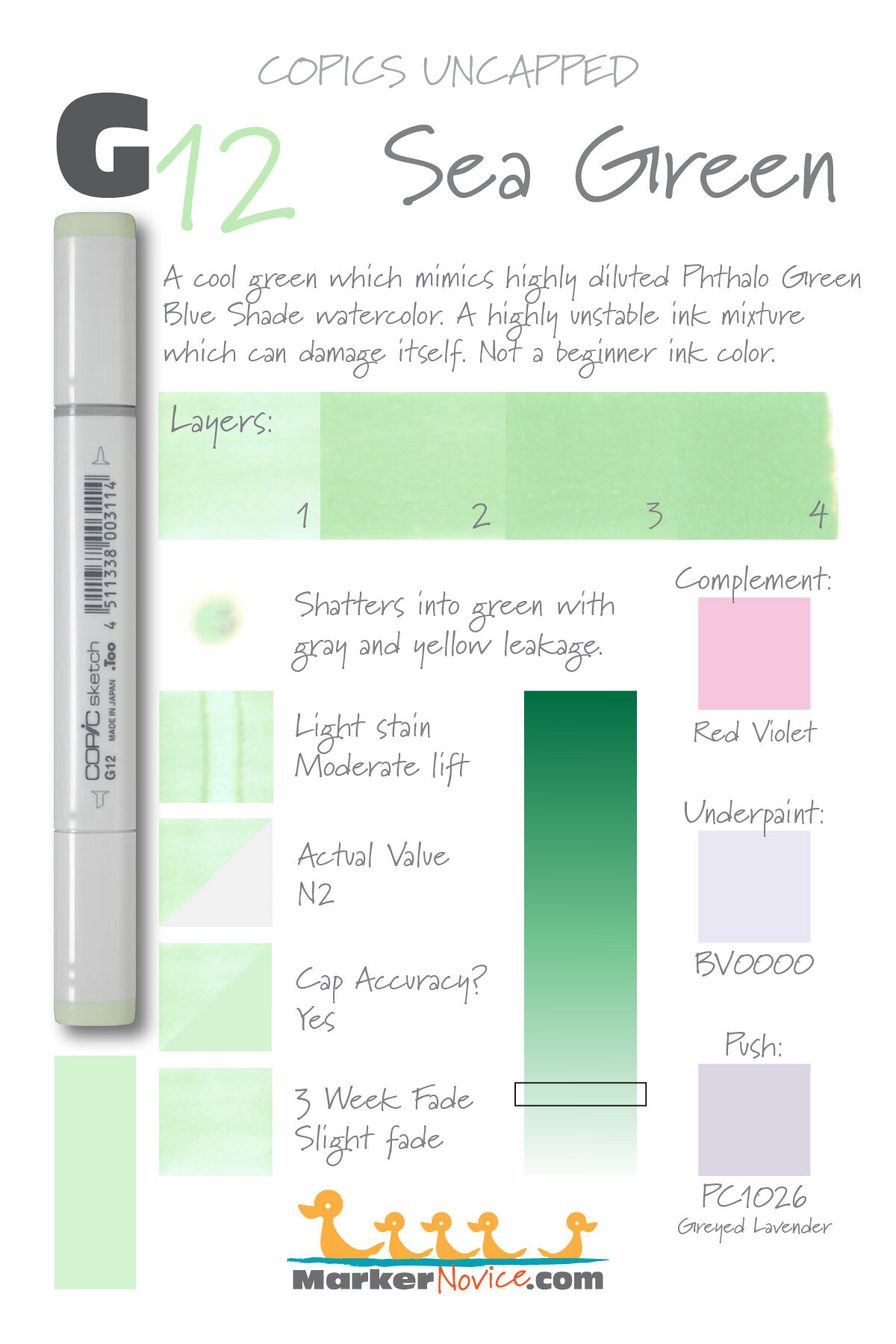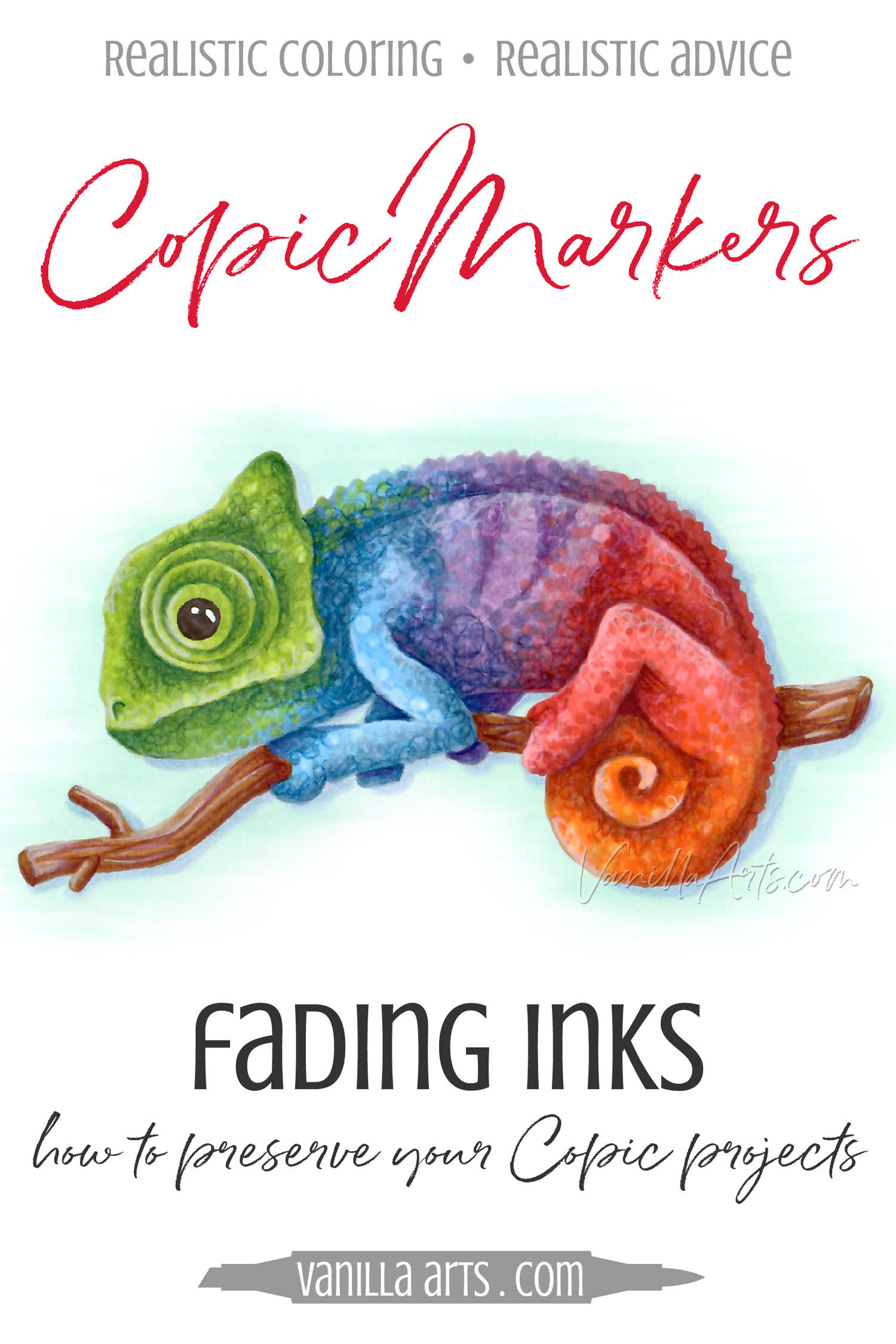Few people get into Copic Markers on a whim because, well… they’re expensive!
Most people research a lot about markers before making that first purchase. And yet whenever I tell students in my Copic art classes that markers are not lightfast, a few people always gasp in complete shock.
“Copic Markers fade? But they’re artist-grade markers!? This is not what I expected!”
It’s true. All markers fade. Let’s look closer at why.
Copic Markers are not lightfast. All art markers fade. Illustration markers were developed for fast design-work rather than framable art. Alcohol inks use dye for vivid, transparent color. Unfortunately, dye is fugitive and fades with exposure to light, heat, humidity, and even time.
What is fugitive ink and how can we prevent fade?
Note: this article contains affiliate links to products mentioned. We only link to products we endorse and we source them to retailers we use and trust.
Markers are made with dye. Dye fades.
There’s a reason why they call them magic markers— making pretty stuff has never been so easy.
But gorgeous color and ease-of-use has a price.
All illustration markers, whether they’re alcohol based or water based, expensive or cheap… All art markers are made with a combination of solvent and dye*.
“Triple Scoop” a Copic Marker project with colored pencil and gouache details. Image and coloring by Amy Shulke of VanillaArts.com and MarkerNovice.com
Usually when someone purchases markers, they check to see they’re alcohol or water-based. (For more about the water vs. alcohol decision, see my article here.) Because alcohol markers are more expensive, we tend to think of them as being premium products; they’re supposedly much better than the average kiddie marker.
So we leap to conclusions, assuming premium markers are lightfast. After all, all the good card making and scrapbooking products are archival, the markers must be lightfast too, right?
Nope.
Art markers are made with dye and all dyes fade.
Some dyes fade fast, some fade slow but they all fade. As the colorful dye particles break down, the marker ink slowly discolors or disappears completely.
In textiles (fabrics), dye manufacturers have developed dyes which last much longer; but permanent dyes require pre-treatment and post-treatment— sometimes with high heat, sometimes with acids or chemical baths. Long lasting fabric dyes are simply not practical to use as marker ink.
Until there’s some great leap in dye technology, we’re stuck with illustration markers which use colors that fade.
—————
*The exception to dye markers was Winsor Newton Pigment Markers (now discontinued) which were made with pigment rather than dye. These markers were guaranteed to be lightfast for 100 years but they were not user friendly and clogged easily. This is typical of pigments, they’re more lightfast and often archival but pigment particles are large and not soluble in alcohol or water. Pigments make markers very finicky and inconsistent.
inks made with dye are fugitive
“Fugitive” is the artist’s term for a color which disappears.
All marker dyes are fugitive.
Fugitive color starts fading as soon as you apply it to the paper or other substrate.
Why do fugitive inks fade?
Marker inks fade because dye is an unstable chemical compound. It’s not durable or permanent. The molecules aren’t very happy to be joined together and they’ll use any excuse to separate.
Which conditions encourage dye to fade?
Light: most people assume it’s UV sunlight (ultraviolet radiation) which fades color the most, but florescent lights are just as bad. See my article here for an example of extreme Copic fading under florescent lights.
Humidity: have you noticed antique fabrics and paper in a museum are usually behind glass? Conservationists know that dyes fade faster in humid places. Even if the dye isn’t water soluble, dye particles stay structurally intact longer in low humidity environments.
Oxygen: speaking of museum glass cases, they’re not just controlling humidity. Museum cases are filled with a nitrogen or argon rich air blend, reducing the destabilizing effect of oxygen exposure.
Temperature: high temperatures, even gentle warming can damage the structural integrity of dye inks.
Acidic paper: non-archival paper not only turns yellow and brittle, the acids in paper create an inhospitable environment for dyes.
Time: this is the hardest thing for marker colorers to understand. Even if you store your marker project in ideal museum conditions, you still can’t stop the aging factor. Marker dyes are unstable, treat them perfectly and they’ll still break down over time.
How fast do Copic Markers fade?
Each dye has its own unique composition and structure; every color has its own durability and level of lightfastness.
From the Copic Website:
Q: Will artworks made with Copic fade over time?
A.Since we use dye ink, the colors may fade over time when exposed to strong UV light. It also depends on the specific color and the amount of light - some colors may start fading after several hours or days, while some may not change at all.
Marker formulas fade at different rates— sadly, consumers have never been given accurate product information on which colors fade, how fast they fade, and which colors are so fugitive that they’re pointless to use on long term projects.
Too, the parent company of Copic doesn’t seem bother with lightfast testing. If they do, they don’t share the test results. To be honest, I’d be shocked if they tested their inks; ASTM testing is expensive and it’s completely useless for products which begin to fade in a matter of hours.
Yes, I said “hours”… look at the quote (on the right) from the Copic website!
The lack of detailed lightfast information is why I started the Copics Uncapped series here at Marker Novice
At the bottom of the left side squares, you’ll find my miniature version of the Blue Wool testing method for inks and dyes. Read more information about the Blue Wool method here.
Because we already know Copics are not lightfast, the question isn’t if they fade. Instead, we want to know how much and how fast.
To provide a better look at how early the fade starts, I shortened the Blue Wool standard time from 3 months to 3 weeks.
Most Copic samples show noticeable results after just 2 weeks but I test an additional week to get a feel for how extreme the early fade will be.
Note: My testing is more casual than standardized Blue Wool testing. I run about 30 colors at a time because that’s how many can fit on my sunniest windowsill. Unfortunately, I can’t run 358 tests at once, so I give winter test swatches a little extra window time to make up for the lack of bright sunlight. It’s not precise but I’m giving you more information than Copic has ever provided.
This is also a solo project, so be patient. I publish a few new results each week as I assemble them.
As you browse through my test swatches here, you can see which colors fade immediately and which sit relatively unchanged for the full test period. A fast-fader is a color you may want to avoid if you intend to keep the project around for years.
But I’ve never noticed any fading!
There’s always someone in some online group who claims to be the exception to the rule.
“I don’t think you need to worry about markers fading. I’ve got a bunch of old projects and I don’t see any changes…”
They’re wrong.
The reason I test Copic lightfastness is to provide concrete evidence of the fade instead of listening to random internet strangers swear it doesn’t happen.
The fade isn’t always as striking as you see on my Chameleon project. The fade can be subtle.
I don’t usually notice general overall fading until I compare one of the project pics on my website to the original project in my hand.
And remember, the whole project is fading, not just one color in one spot. The human brain has a terrible memory for color, so if you’re looking at something everyday, you’re unlikely to notice a total decrease in overall vibrancy.
The people who can’t see the fade are not comparing befores and afters.
But artists know better! So why do use markers which fade?
Markers were never intended to make framable art.
When I mention to classes that Copic Markers are not lightfast, someone always asks:
“Oh no! I only use lightfast products! Which marker should I switch to?”
You can’t switch. The only lightfast marker (Winsor Newton Pigment Markers) were difficult to work with and I wasn’t surprised when they were discontinued.
I know this stinks. There are so many cool markers out there; it’s not fair that they fade! Why can’t we have lightfast markers?
Technology has its limits, this is one of them.
But here’s the issue I have with hobbyists who get angry about markers not being lightfast…
You’re walking into something with 10 minutes of experience and no knowledge of how professional artists use art markers.
Art markers were developed for illustrators and designers— artists like graphic and commercial artists, storyboard artists, fashion and interior designers, landscape designers and architects. Professionals use markers for idea brainstorming and fast visual communication between team members. We get an idea and we quickly scribble it on cheap paper, then we throw it away a few weeks later.
Markers are made for disposable art.
Artists need disposable art mediums. The fact that marker fades is not a design flaw, it’s an asset. Creative people use markers to spark creative ideas. For ideas to flow, you want to generate a lot of ideas, fast. We throw away the bad ideas and develop the good ideas into great ideas.
Markers are the artist’s version of a chalk board— the disposable transient nature of marker sketching encourages greater creativity.
When you enshrine an idea or a drawing as if it’s the best thing you’ve ever done or ever will do, you stifle further creativity.
Now I know, I’m a bit of a hypocrite. I teach advanced marker painting classes where we spend lots of time coloring extravagant projects which look like paintings. But I don’t expect anyone’s class project to hang on a museum wall. It’s an assignment, it’s an experiment, it’s practice— it’s not art.
If I were to create something truly amazing with markers, something worth keeping and framing, there’s a simple solution: Scan the project and have it professionally printed.
And honestly, if I think I’m onto something truly great, I don’t use markers. I use a lightfast medium on archival paper.
I don’t need or want a marker that lasts forever.
Tips for preserving Copic Marker art
I try to explain to students about the disposable nature of marker art and how your class projects are just exercises but students always ask…
“What if I really want to save my project? What can I use to prevent my marker project from fading?”
Best practices:
Work like a graphic artist: Always scan your fresh artwork at 600ppi and save the unedited original digital copy in at least 2 locations. I save my art to an exterior hard drive, an offsite server, and the cloud.
Archive your original marker projects: Keep your projects stored in archival boxes, separated by smooth (no folds) sheets of glassine, with desiccant packets taped to the lid box (not touching the artwork). Projects will still fade because you’re not controlling for oxygen inside the box (and the humidity control is iffy) but for the average colorer, I honestly think this is the best you can do.
To sell marker art or frame it for personal use: I have professional giclee prints made from the digital scans. Only sell prints; never sell marker originals. I know some people say “you can sell marker art if you warn the buyer” but I think this is dishonest. You can tell a customer the marker will fade but the truth of that statement doesn’t really sink in until the art fades and then they’re disappointed or mad at you. Only sell prints and keep your good reputation!
To hang framed artwork: Whether you’re hanging original Copic art behind UV glass, a giclee print, or even an oil painting, wall placement for art is incredibly important. Never hang ANY art across from a window where it will receive direct sunlight. Also never hang art in a bathroom or near kitchen appliances where temperature and humidity constantly rise and fall.
Products student ask about (and why I’m skeptical):
Storing projects in books, folders, portfolios: This isn’t a terrible idea, it does prevent UV fading and also keeps the artwork accessible for periodic viewing. Students enjoy flipping through my class samples in these portfolio books, but I do think archival boxes provide better overall protection.
Framing original marker art behind UV glass: Let’s be clear, not all UV glass is created equally. The quality and benefits of UV glass ranges from the cheap UV glass in standardized frames all the way up to museum quality sheet glass. UV glass works by bending UV rays away from your project. Better UV glass bends more rays but even the best glass can’t bend them all. No UV glass is totally protective and good UV glass looks exactly like plain old ordinary glass. I often wonder if the cheap imported frames at Hobby Mart are actually UV glass because nobody is Hobby Mart is checking!
Please note: if you’re framing something you love, spend the extra money for professional framing.
Professionals use a higher grade glass plus archival mats and spacers.
Framers understand how much space each medium needs between the surface of the art and the glass.
Professionals seal the back of the frame for added oxygen and humidity control.
Over the years, I’ve seen a ton of doomed self-framed projects which kiss the glass or rattle loose behind a mat. Framing art wrong can be worse than not framing it at all.
Sealing with UV protective spray fixative or varnish: USE EXTREME CAUTION! UV Archival Sprays like this usually employ alcohol or acetone as either propellant or solvent (MSDS sheet here). Alcohol is a big no-no for alcohol marker projects. Even as a propellant, alcohol sprays leave spots. I’ve tested acetone, it acts like bleach on Copic.
Aside from the solvent/propellant issues, UV sprays work like UV glass, bending light rays away from the artwork. Unlike glass, to be truly effective, varnish must be applied very evenly in several coats from multiple directions. Very few people take the time to learn how to varnish properly.
An alternative UV varnish: Brush-on Polymer Varnish like this might work for markers but it uses ammonia as the solvent and I’ve never tested ammonia on markers (MSDS here). I also wonder if ammonia can throw off the ph levels which dye needs to retain its structure. Golden is a brand I trust but honestly, this kind of varnishing is far more work than I’m interested in.
One recent thought I’ve had… they make UV plastic pouches for use with lamination machines (here’s one brand, here’s another from a similarly reputable brand). I’ve not tried the UV specific types but it seems like a good solution to UV which would also limit humidity and oxygen exposure at the same time. My concern is how much heat the lamination machine uses to bond the plastic to the artwork. Also, lamination is irreversible and unfixable. I’ve laminated a lot of class materials and they frequently leave bubbles… am I willing to risk my art? BTW, when I laminate color wheels and charts for classes, I use this thermal-lamination machine with these non-UV pouches.
To summarize:
It can be discouraging to invest time and money into Copic or other marker brands, only to find out how fast these markers fade.
The lack of lightfastness is something I wish more instructors would cover in their beginner classes and articles. But sadly, I suspect many coloring instructors don’t even realize markers are not lightfast. I’ve been talking about it in classes for years and I still encounter people every time who have never heard that markers are fugitive.
Copic Markers are not lightfast. All alcohol markers fade.
Markers use a combination of solvent and dye for inks that are vivid, bright and radiate color like stained glass. Unfortunately, dye is fugitive. Some fugitive colors last for only weeks while others stay vibrant for years but they all eventually fade.
Marker inks fade due to:
UV light rays from the sun and UV light rays from incandescent or florescent lightbulbs
Oxygen
Heat
Humidity
Ph imbalance with non-archival papers
Even just gradually over time
But this is not a new problem, permanent markers have never been as truly permanent as the name implies.
Graphic artists and designers understand the transitory nature of marker inks, enjoying markers for their color and the way they spark creativity. The temporary nature of a marker provides creative freedom and lessens the drive for perfection.
Markers are for play.
If it’s truly amazing work, then capture the magic in a digital scan and have your marker art professionally printed.
Or switch to a lightfast medium, once you’ve developed the idea with markers.
That’s the artist’s approach to markers— have fun and relax.
Not everything has to last forever.
Amy Shulke is a professional illustrator who has used Copic Markers since 1990. She teaches artistic coloring classes online at VanillaArts.com and locally in south-eastern Michigan.
Marker Novice is Amy’s completely free resource devoted to beginner marker education. For intermediate/advanced artistic coloring articles, see her Studio Journal here.
Further reading on related topics:
We all scream!
3 scoops of ice cream
Are you ready to customize a project? Pick your favorite flavors and color this tasty treat!
Amy Shulke’s "Triple Scoop"
Sample shown uses Copic Markers and Prismacolor colored pencils.
Package includes PNG digital stamp with easy print PDF option plus recipe, full color sample, photo reference, and grayscale guide.


































